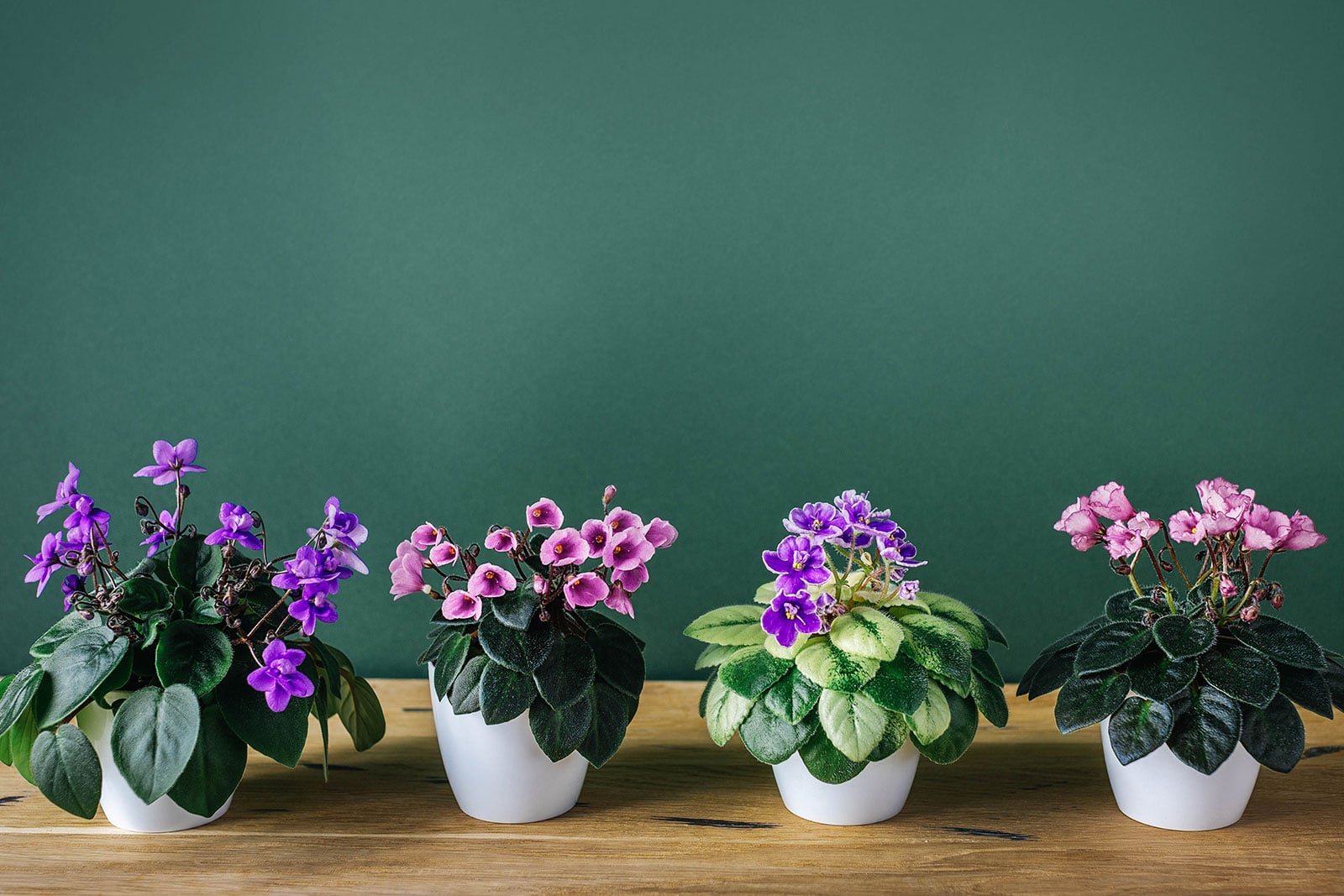Looking for a flowering houseplant to brighten up your home? Why not consider one of the classics: Saintpaulia, or the African violet. There’s a reason your grandmother likely had one on her windowsill! These African natives are perfectly suited to indoor growing and bloom almost year-round with the right care.
Keep reading for African violet growing tips and everything you need to know about caring for an African violet indoors!
| Common name(s) | African violet, Saintpaulia |
| Scientific name | Streptocarpus sect. Saintpaulia |
| Family | Gesneriaceae |
| Height and spread | Up to 6 inches high and up to 12 inches wide |
| Light | Bright indirect |
| Soil type | Loose and well-draining (African violet soil) |
| Water | Keep lightly moist |
Disclosure: If you shop from my article or make a purchase through one of my links, I may receive commissions on some of the products I recommend.
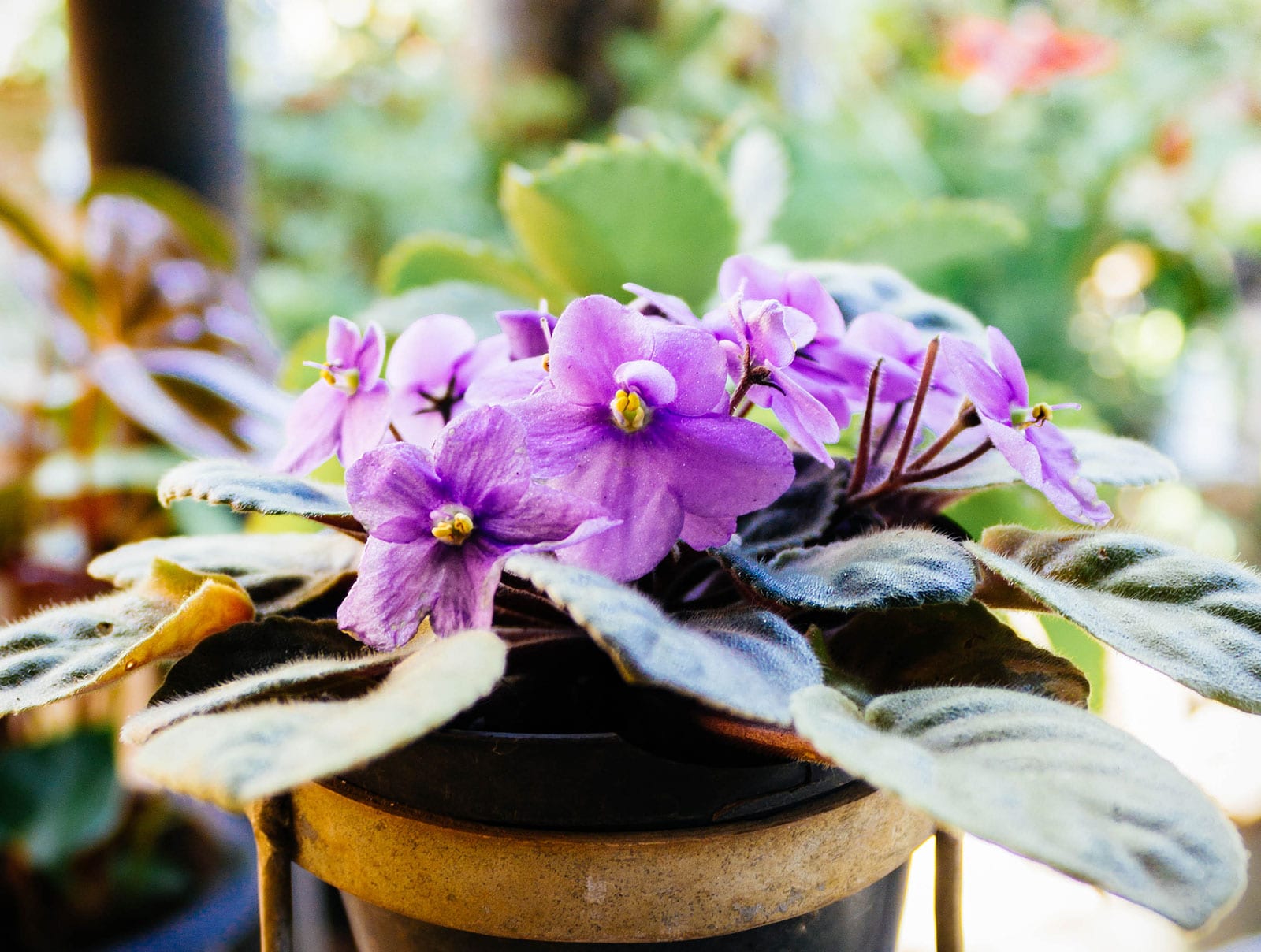
About African violets
Description
African violets are very decorative little plants that bloom in lovely jewel tones. Even when not in bloom, you won’t have trouble recognizing one, as they sport uniquely fuzzy leaves that give them an almost shiny appearance. They stay small, making them perfect for the average windowsill.
Keep in mind that you’ll be hard-pressed to find two African violets that look exactly the same, especially when it comes to their flowers.
These plants have been very extensively hybridized to produce blooms in different colors (blue, purple, pink, white), patterns (bi-color, mottled, white-edged, speckled) and shapes (single, double, frilled, star-shaped).
There are even variegated Saintpaulia with white or pink marbled leaves, as well as miniature plants that never grow more than 6 inches in diameter.
African violet plants are categorized by their growth: rosette and trailing.
Rosette African violets are single-crown plants with leaves that grow outwards from a central stalk in a circular pattern. The leaves stay close to the surface of the soil and flowers grow within the center of the plant.
Trailing African violets are multi-crown plants with multiple stems that grow sideways and have a cascading growth habit. Stems are longer than on rosette types, and flowers grow from each crown, giving the plant a bushy appearance.
Natural habitat and history
As their common name suggests, these plants are naturally found on the continent of Africa. They were first officially described in the late 19th century.
This happened after a German colonial official stumbled upon one species, later named Saintpaulia ionantha, in the humid, shady cloud forests of the East Usambara Mountains. This region is located in what is now Tanzania and is an area considered to be of great ecological importance. It’s actually on the list of Earth’s “biodiversity hotspots.”
Seeds were sent back to Europe and the rest is history—the African violet craze hasn’t died down since. The first hybrids and cultivars appeared very quickly, but the plant’s taxonomy remained a mess for many years. In fact, the whole thing was resolved only quite recently. It’s a bit of a wild ride!
After its initial introduction into Europe, the genus was named Saintpaulia. It was expanded to no less than 20 species at one point, but further research led to reductions.
As of 2015, it has been confirmed through molecular studies that African violets aren’t actually even an individual species at all. They were thus moved to Streptocarpus (the Cape primroses), where they still remain, although they inhabit a special section within this genus: Streptocarpus sect. Saintpaulia.
Did you know? As authors of a 1998 scientific paper describe it, it’s “sadly ironic” that despite their huge popularity as houseplants, several species of African violets are actually endangered in their home countries of Tanzania and Kenya. Habitat loss due to agriculture is one of their biggest threats.
Cultural significance and uses
Popular right from the start, African violets are now deeply rooted in the houseplant hobby—pun intended! They’re mainly sold for Mother’s Day, although they’re also popular for Easter and Valentine’s Day (and even Christmas, since they stay in bloom for much of the year).
Read more: 10 Cheery Holiday Houseplants to Grow If You’re Bored With Poinsettias
In flower symbolism, African violets stand for loyalty, devotion and faithfulness.
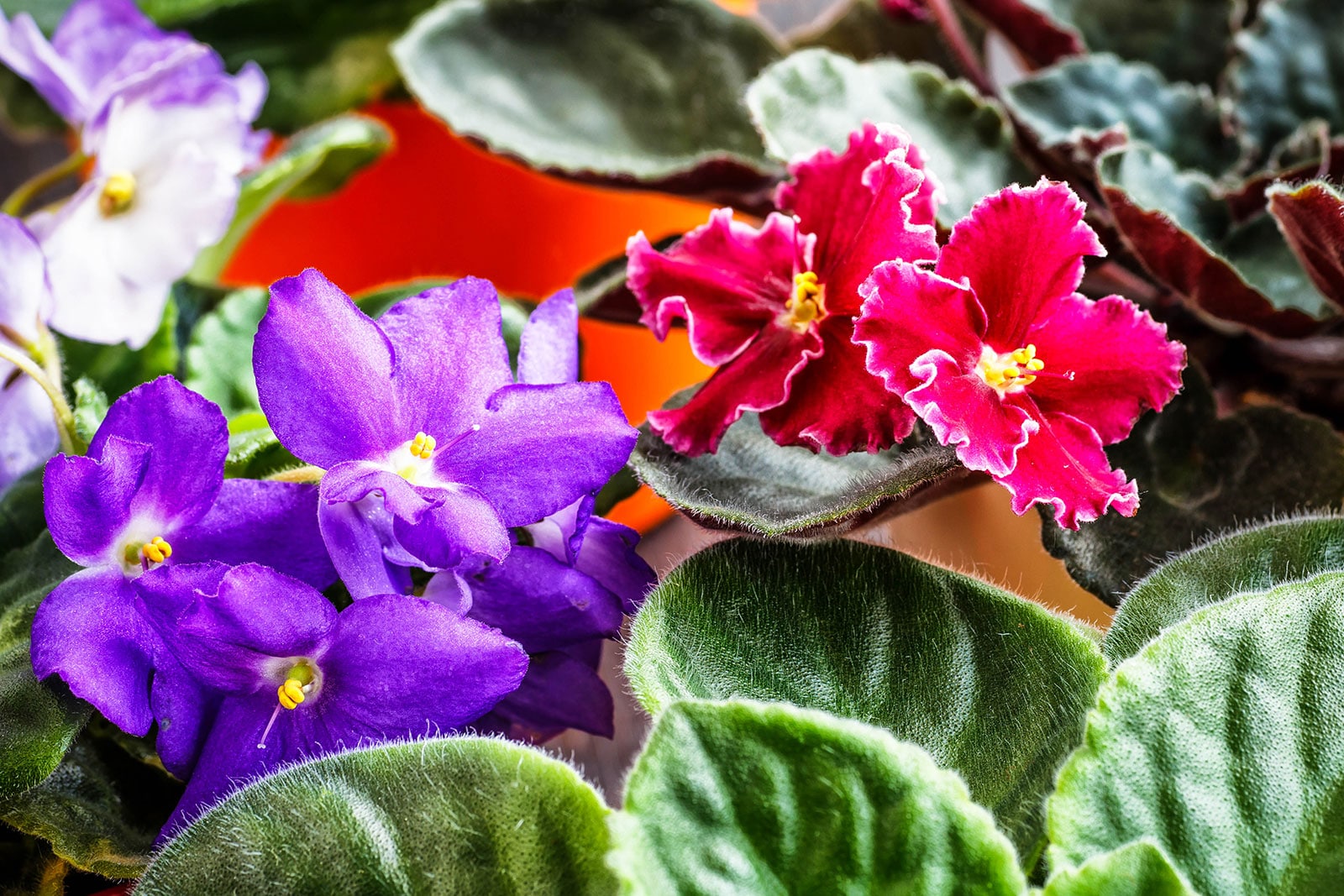
African violet varieties
As I mentioned, and as with many other houseplants, there are so many different African violet varieties out there that it would be absolutely impossible for me to even try to describe them here.
Officially, Streptocarpus sect. Saintpaulia contains 10 species, but the amount of hybrids out there (registered or not) is pretty much endless. Most of them originate from Saintpaulia ionantha, the first African violet to be described officially, but some have since been mixed with other species.
We typically think of purple African violets when it comes to these fuzzy-leaved plants, but in fact African violets come in a variety of colors, in every shade of purple, blue, red, pink, and white.
If you’re curious about what’s out there, the African Violet Society of America has a gallery containing thousands of photos for you to explore.
Here are a few of my favorites:
- African Violet ‘Persian Prince’: A miniature variety with blue pansy flowers and fleshy, scalloped leaves.
- African Violet ‘Pixie Blue’: A miniature trailing variety with bluish purple single flowers.
- African Violet Optimara ‘Little Maya’: A semi-miniature variety with crimson flowers and heart-shaped leaves with red backs.
- African Violet Optimara ‘Rose Quartz’: A miniature variety with pink flowers and glossy green leaves.
- African Violet ‘Lonestar Snowstorm’: A standard variety with frilled, semidouble white blooms with tiny yellow centers.

Caring for an African violet
I’ve noticed that African violets have a bit of a reputation for not being the easiest houseplants to keep alive (compared to say, spider plants, which practically take care of themselves). I think this is because African violets are somewhat specific about certain care aspects.
If you keep their natural habitat and the way they grow in mind, though, there’s no reason you shouldn’t be able to grow beautiful Saintpaulias and have them flower almost constantly.
Imagine being part of the undergrowth in a tropical African cloud forest for a second (quite a relaxing thought!).
Some months it rains literally every day, meaning it’s often cloudy. Taller trees block out direct sunlight. Temperatures never really drop below 60°F, even at night. Humidity is always 75 percent or more.
Light and temperature
To figure out the right light levels and temperature for this plant, all you have to do is refer back to the cloud forest. Doing so, it’s not difficult to imagine that African violets aren’t used to direct sun. They love light, but indirect is best.
Being from the tropics, they’re also not used to the cold: room temperature is perfect, or at least keep things above 60°F. Be sure to avoid placing your Saintpaulia too close to drafty windowsills or AC vents.
Water and humidity
African violets are quite specific about two things when it comes to watering: they don’t like cold water, and they don’t like their fuzzy leaves getting wet. You can bottom water with lukewarm water, or at least be careful to avoid splashing the foliage.
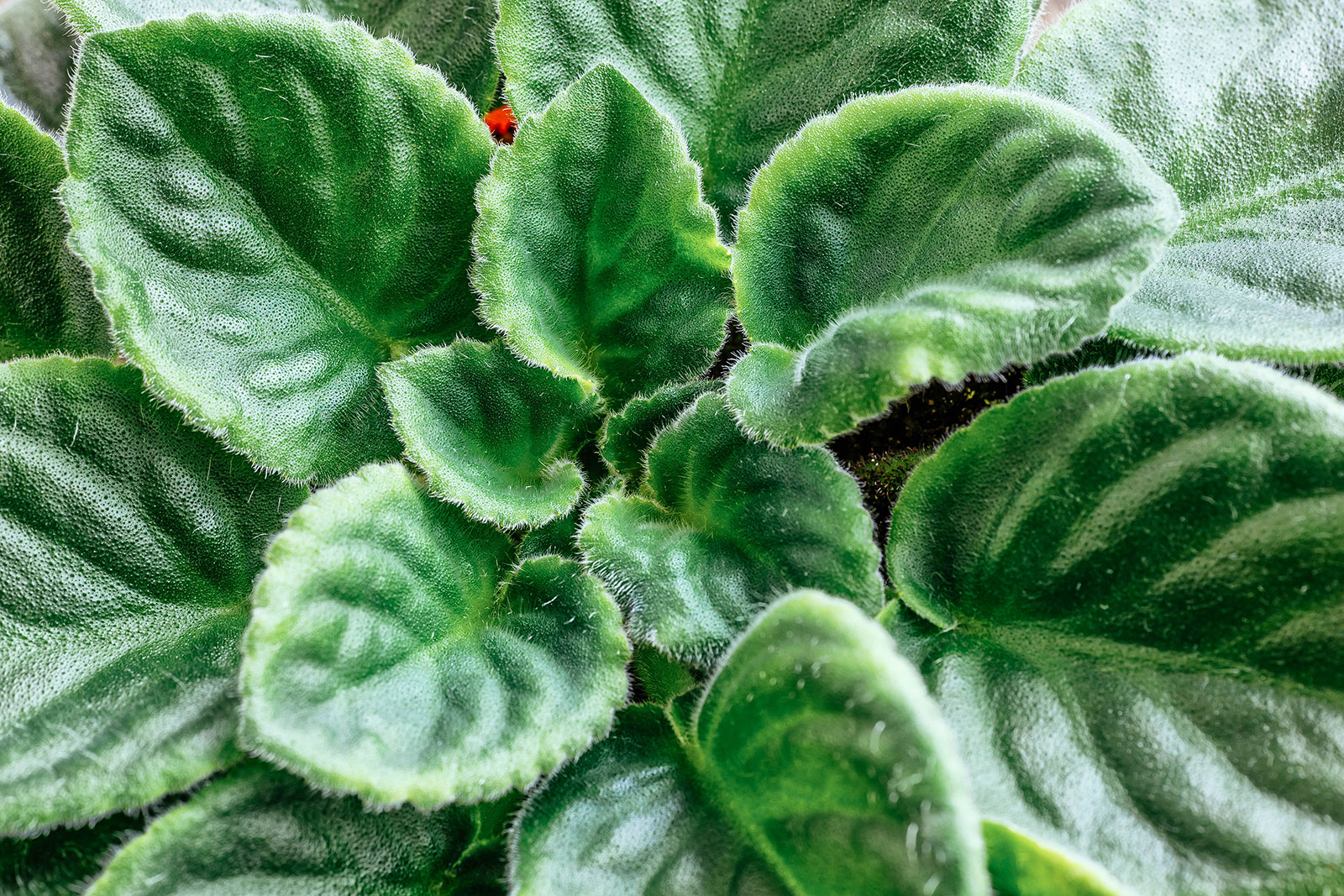
These plants definitely like their soil lightly moist, especially during the summer growing months. Like most other houseplants, though, they don’t appreciate wet feet and sitting in excess water. Don’t overdo it!
I can’t tell you when to water your plant exactly, because that depends on the environment, but it’s not too difficult to figure out using the finger test.
If you stick a finger in the soil and it’s still quite damp, wait another day or two.
If it’s more or less dry, you can give your Saintpaulia a drink. Is it bone dry, possibly with the plant’s leaves looking droopy? Don’t wait as long next time.
Although no one expects you to maintain tropical humidity levels in your home, some air moisture is appreciated. If the humidity regularly falls below 50 percent, you may want to run a humidifier to help out your houseplants (or consider moving them to the kitchen or bathroom, which are usually more humid than other rooms in the home).
Soil and planting
Because African violets don’t like sitting in water, a well-draining soil mixture is the way to go. Most growers prefer a medium that doesn’t contain any potting soil. You can buy pre-mixed African violet soil, but you can also opt to make your own.
The classic Saintpaulia mixture contains two parts sphagnum peat moss, one part vermiculite and one part perlite.
When it comes to planting, the most important thing is to use a container with a drainage hole. It doesn’t have to be large, nor do you have to repot very often, as this species doesn’t mind being a bit cramped.
Recommended products for African violet plant care:
- Espoma Organic African Violet Potting Mix
- Black Gold African Violet Potting Mix
- Hoffman Organic African Violet Soil Mix

Self-watering ceramic or plastic pots make the best African violet pots, as they’re small (usually no more than 4 to 5 inches) and provide the proper amount of continuous moisture to your plants while allowing adequate drainage.
Ideal pot sizing is about one-third the size (diameter) of your African violet plants. That means miniature African violets are happiest in 1- to 2-inch pots, while standard-size African violets should be in 3-inch pots. Trailing African violets like to be planted in shallow pots with a minimum depth of about 2 inches.
Why is pot sizing important? African violets planted in too small or too large of a container may not grow to their full potential. Growth may be slower, leaves may be smaller, and buds or blooms may not appear consistently. Choosing an appropriate African violet planter from the get-go helps your plant develop more fully.
Recommended African violet pots:
- Hand-painted 5-inch self-watering planter (woodgrain pattern)
- Glazed teardrop 6-inch self-watering pot (ceramic)
- Set of 3 modern square 4-inch self-watering pots (plastic)
- Set of 4 modern shallow terracotta pots with saucers (3-inch, 4-inch, 5-inch, 6-inch)
- Set of 4 modern black 4-inch pots with saucers (ceramic)
- Set of 12 miniature white 2-inch pots with bamboo saucers (ceramic)
Fertilizing
This one’s easy, as most plant shops and garden centers will sell special African violet fertilizers that contain everything your plant needs. If your Saintpaulia is healthy and chugging along, apply a little fertilizer every other week according to the instructions on the label.
Recommended fertilizers for African violets:
- Espoma Organic African Violet Plant Food
- Houseplant Resource Center African Violet Plant Food
- EarthPods African Violet Organic Fertilizer Spikes
Pruning
Unless you want to do so for aesthetic reasons, there’s no need to prune an African violet. You can remove dead leaves and spent flowers as they occur, though.
Dividing or repotting
Unless your African violet seems stressed and has roots sticking out of the pot’s drainage hole, you probably won’t have to upgrade it to a larger planter. They do appreciate a soil refresh once in a while and it can help to remove any offsets to prevent overcrowding.
When repotting, African violets prefer to move up in 1-inch increments. So if your plant has been in a 2-inch pot, move it into a 3-inch pot (and so on).
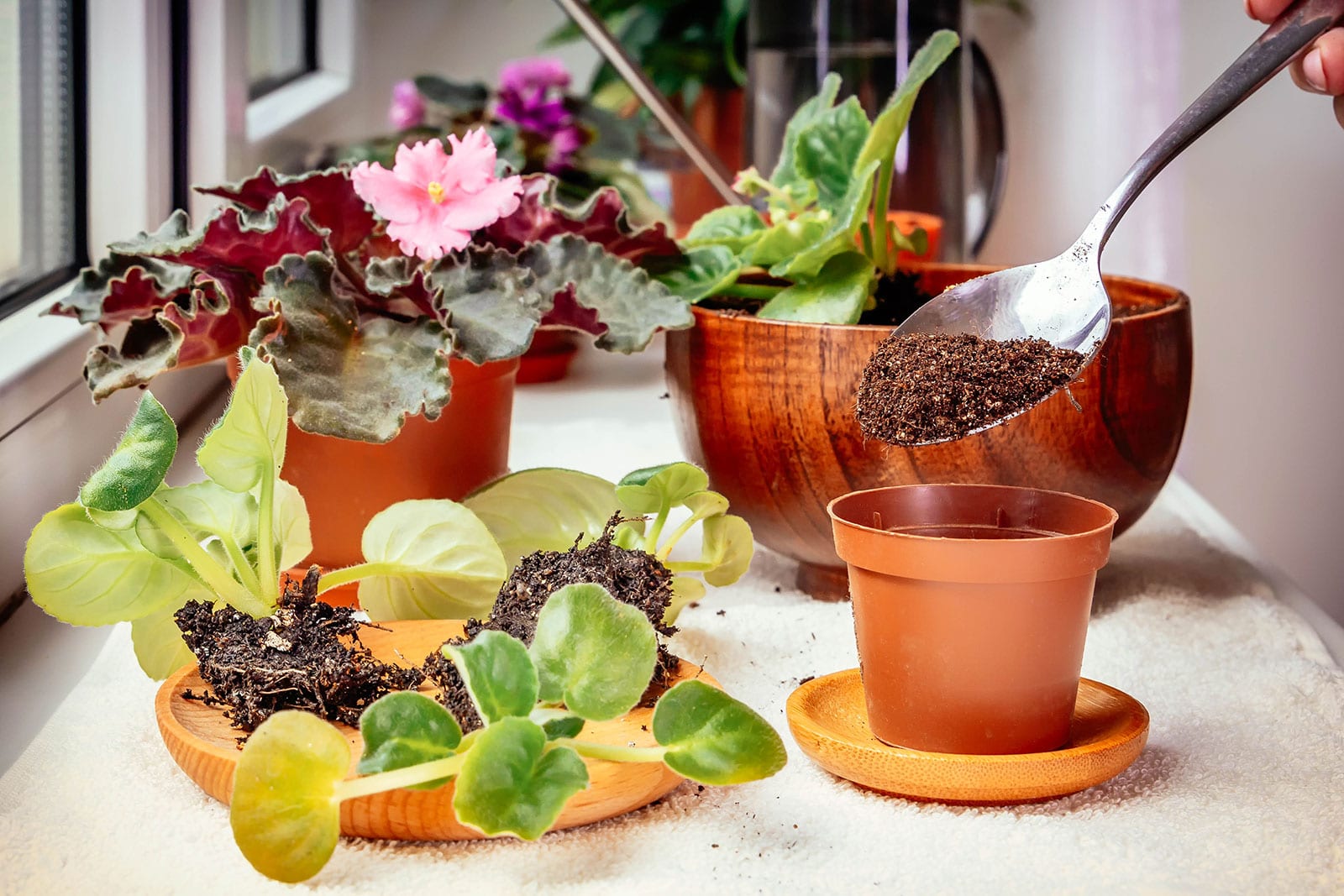
Propagating African violet
Multiplying an African violet is an absolute breeze and a great way to obtain free plants to keep or give away. In some cases, the plant itself will do most of the work for you: this species is known to produce offsets, which you can remove and pot up separately.
If your African violet doesn’t have any offsets but you’d still like to propagate it, no worries. This is actually a species that can be multiplied using a single leaf!
There are two easy ways to propagate an African violet.
Rooting an African violet leaf in soil
- Pinch out a leaf close to the middle of the rosette, leaving some of the leaf stem attached.
- Prepare a small 1- to 2-inch container with some African violet soil.
- Bonus step: Dip the leaf stem in some rooting hormone.
- Insert the leaf stem into the soil pointing downward. The leaf itself should still stick out.
- Lightly moisten the soil.
- Bonus step: Place the container with the leaf in a clear plastic baggie to create a mini greenhouse.
- Place the container in a bright but not sunny spot, preferably nice and warm.
- Be patient!
The first baby plantlets should start sticking up from the soil after one to three months. One leaf can produce a bunch of new African violets! Pot the plantlets up separately once they’ve got a few mature leaves each.
Rooting an African violet leaf in water
- Pinch out a leaf close to the middle of the rosette, leaving some of the leaf stem attached.
- Fill a wide-mouth jar or glass with 1 inch of lukewarm or warm water.
- Place the stem (freshly cut, if it’s been more than a minute since you took it from the mother plant) in the water, making sure only the stem is submerged.
- Change the water every week with fresh warm water. In two to four weeks, the first roots will form at the bottom of the leaf.
- Bonus step: Add a small drop of liquid houseplant fertilizer to the water.
- A month or two after the roots appear, you’ll see a tiny new African violet leaf develop next to the base of the stem: this is your new plant. The mother leaf will eventually wither away; gently remove it from the baby leaf when this occurs.
- When the new leaf is at least 1/4 inch in size, pot it up in a 1-inch container filled with African violet soil and keep lightly moist as the baby plant grows.
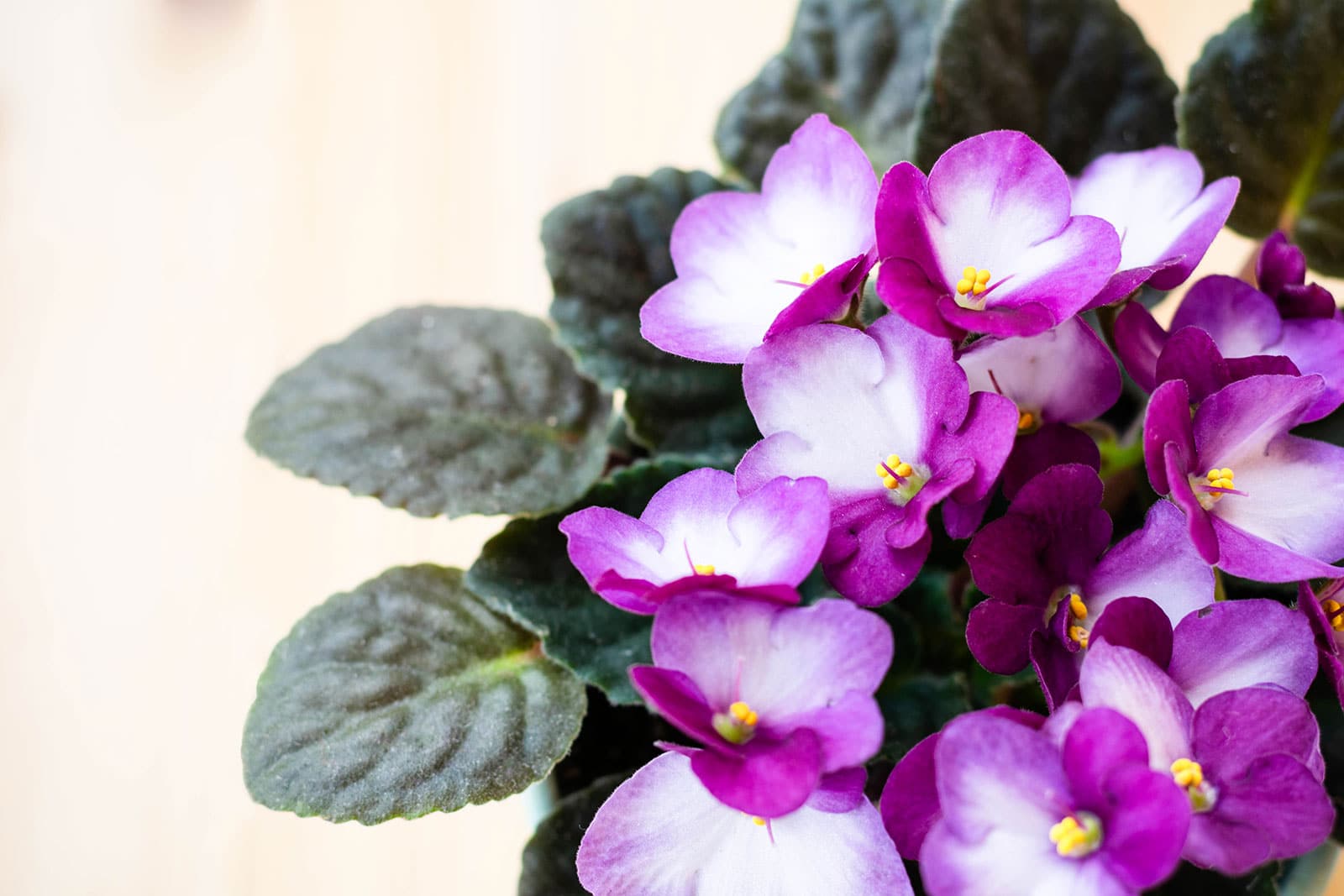
How do you make an African violet bloom?
If your African violet has stopped flowering, it can be a good idea to refer back to this care guide and make sure you’re still following all care guidelines. After all, they usually tend to bloom almost constantly, although a short break isn’t too concerning.
The main reason for a Saintpaulia failing to bloom is light. Are you sure you’re supplying enough?
If you don’t have a bright windowsill to offer, you may want to try supplementing with some artificial light. You can also remove any offsets your plant may have in order to refocus its energy on blooming, as well as apply some fertilizer or even repot if it’s been a long time.

Common questions about African violets
How many varieties of African violets are there?
Officially, there are 10 species within Streptocarpus sect. Saintpaulia but thousands of hybridized varieties. The African Violet Society of America currently has more than 16,000 varieties listed in its database, grouped by their growth and by their flowers.
What is the easiest African violet to grow?
Trailing African violets are my pick for the easiest type to grow at home. The plants naturally branch and spread and do their own thing, and there’s no need to remove suckers to encourage blooming or maintain the plant’s symmetry.
Are African violets toxic to cats and dogs?
Nope! Although it’s still a good idea to keep them away from children and curious furry friends just to protect the plant, African violets are absolutely safe.
Sources:
Chen, J., & Henny, R. J. (2009). Cultural Guidelines for Commercial Production of African Violets (Saintpaulia ionantha). EDIS, 2009(2).
Christenhusz, M. J. (2012). On African violets and Cape primroses—towards a monophyletic Streptocarpus (Gesneriaceae). Phytotaxa, 46(1), 3-9.
Eastwood, A., Bytebier, B., Tye, H., Tye, A., Robertson, A., & Maunder, M. (1998). The conservation status of Saintpaulia. Curtis’s Botanical Magazine, 15(1), 49-62.


